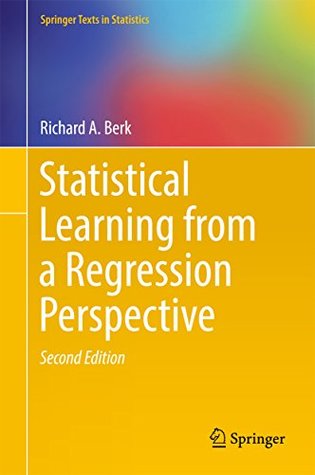Download Statistical Learning from a Regression Perspective (Springer Texts in Statistics) - Richard A. Berk | ePub
Related searches:
Free Online Course: Statistical Learning from edX Class Central
Statistical Learning from a Regression Perspective (Springer Texts in Statistics)
Statistical Learning from a Regression Perspective Richard
Statistical Learning from a Regression Perspective SpringerLink
(PDF) Statistical Learning From a Regression Perspective
An Introduction to Statistical Learning from a Regression
(PDF) Statistical Learning from a Regression Perspective
[PDF] Statistical Learning from a Regression Perspective By
Notes from the book: Statistical Learning from a Regression
Statistical Learning from a Regression Perspective (豆瓣)
Statistical Learning from a Regression Perspective / Edition
Chapter 1 (statistical learning as a regression problem): chap_1_prob_1. R (overfitting the data) chapter 2 (regression splines and regression smoothers): chap_2_prob_1.
This is a semi-supervised learning problem, in which a statistical learning method that can utilize all observations is needed.
Ap statistics: learn about the course and what advanced placement statistics exam score you'll need for college admission and course credit. Statistics is a popular advanced placement course with over 200,000 students taking the exam annual.
Journal of the royal statistical society: series a (statistics in society), 2009.
Statistical learning is a name for methods that experiment with many di erent models for the data, and which have been a strong focus of data mining and machine learning traditions of data analysis. Here, regression encompasses classi cation as well as regression with a continuous or ordinal outcome variable.
This textbook considers statistical learning applications when interest centers on the conditional distribution of the response variable, given a set of predictors, and when it is important to characterize how the predictors are related to the response. As a first approximation, this can be seen as an extension of nonparametric regression.
This textbook considers statistical learning applications when interest centers on the conditional distribution of a response variable, given a set of predictors, and in the absence of a credible model that can be specified before the data analysis begins.
The special challenges to statistical inference posed by statistical learning; the fundamental connections between data collection and data analysis; interdisciplinary ethical and political issues surrounding the application of algorithmic methods in a wide variety of fields, each linked to concerns about transparency, fairness, and accuracy.
In the world of statistics, there are two categories you should know. Descriptive statistics and inferential statistics are both important.
The material is written for upper undergraduate level and graduate students in the social and life sciences and for researchers who want to apply statistical learning procedures to scientific and policy problems. The author uses this book in a course on modern regression for the social, behavioral, and biological sciences.
Prerequisites; (supervised learning) regression; (supervised learning) classification.
Statistical learning from a regression perspective considers statistical learning applications when interest centers on the conditional distribution of the response variable, given a set of predictors, and when it is important to characterize how the predictors are related to the response. As a first approximation, this is can be seen as an extension of nonparametric regression.
However, it seems to us that so far not enough attention has been given to the theory and applications of modal regression, especially in the statistical learning literature.
Support vector machine (svm) is a machine learning algorithm based on statistical learning theory, and it has recently been established as a powerful tool for classification and regression problems.
This chapter aims to introduce the common methods and practices of statistical machine learning techniques.
Accessible discussion of statistical learning procedures for practitioners with real-world applications in the social and policy sciences. This textbook considers statistical learning applications when interest centers on the conditional distribution of the response variable, given a set of predictors, and when it is important to characterize how the predictors are related to the response.
Features: the first part of the book is an overview of the linear regression model and overall goals of statistical learning. Parts 2 through 8 explain the statistical learning procedures of bagging, random forests, boosting, support vector machines, and neural networks.
Among the statistical learning procedures examined are bagging, random forests, boosting, support vector machines and neural networks. As in the first edition, a unifying theme is supervised learning that can be treated as a form of regression analysis.
Regression is a supervised learning technique which helps in finding the correlation between variables and enables us to predict the continuous output variable.
Jul 27, 2019 linear regression is widely used in biological, behavioral and social sciences to describe possible relationships between variables.
Find tables, articles and data that describe and measure elements of the united states tax system. An official website of the united states government help us to evaluate the information and products we provid.
This hands-on, regression-analysis bootcamp will help you master practical statistical modeling and machine learning in python.

Post Your Comments: